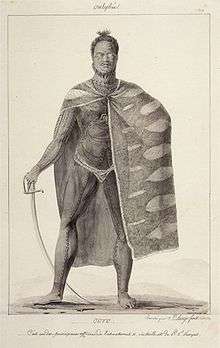Jacques Arago
.jpg)
Jacques Étienne Victor Arago (6 March 1790 – 27 November 1855) was a French writer, artist and explorer, author of a Voyage Round the World.
Biography
Jacques was born in Estagel, Pyrénées-Orientales. He was the brother of François Arago (1786–1853), a scientist and politician, the most famous of the six Arago brothers. His parents were François Bonaventure Arago (1754–1814) and Marie Arago (1755–1845). His four other brothers were Jean Arago (1788–1836), a general in the Mexican army; Victor Arago (1792-1867), a military in France; Joseph Arago (1796-1860), also a military in France and Mexico, Étienne Arago (1802–1892), a writer and politician.
Jacques Arago joined Louis de Freycinet as a drawer on his 1817 voyage around the world aboard the ship Uranie, which inspired his witty Voyage autour du monde.[1] This book had much success and was re-published through several decades with various titles. Having been given a challenge many years later by a lady at a social dinner, he then published Voyage autour du monde, sans la lettre A (Voyage around the world, without the later A), later known as Curieux voyage autour du monde, in 1853, where he tells of his round trip lipogrammatically, that is, without once using the letter "A".[2] The lady replied with a letter without the letter C.[3]
On the Freycinet expedition to Hawaii in 1819, Arago "showed Riouriou a Camera obscura,"[1] the first such ever seen in the Hawaiian islands.
Although Arago lost his sight in 1837, he went on traveling and writing for the theater.
He died in Rio de Janeiro, Brazil. Over forty of his drawings were donated to the Honolulu Museum of Art by Frances Damon Holt.[4]
Works
Plays
- 1825 : Le Compagnon d'infortune ou les Prisonniers, by Emmanuel Théaulon and Jacques Arago
- 1832 : Le Duc de Reichstadt, by Louis Lurine and Jacques Arago
- 1834 : Les Papillotes, by Jacques-François Ancelot and Jacques Arago
- 1834 : Un noviciat diplomatique
- 1836 : Le Cadet de Gascogne, by Léon Buquet and Jacques Arago
- 1837 : Un mois à Naples, by Duplessy and Jacques Arago
- 1838 : Mademoiselle d’Alvigny, lieutenant de dragons
- 1840 : Le Camélia, by Édouard Gouin and Jacques Arago
- 1840 : L’Éclat de rire, by Alexandre Martin and Jacques Arago
Essays
- 1822 : Promenade autour du monde pendant les années 1817, 1818, 1819 et 1820, sur les corvettes du Roi L'Uranie et La Physicienne, commandées par M. Freycinet
- 1824 : Collection de proverbes et bons-mots
- 1824 : Aux jeunes poètes de l'époque
- 1827 : Le Fond du sac ou les Rognures de la censure
- 1829 : Promenades historiques, philosophiques et pittoresques dans le département de la Gironde
Gallery
 Ooro, One of the Principal Officers of Kamehameha II, pen and ink wash over graphite, 1819, Honolulu Museum of Art
Ooro, One of the Principal Officers of Kamehameha II, pen and ink wash over graphite, 1819, Honolulu Museum of Art_by_Jacques_Arago.jpg) Tattooing, Sandwich Islands, Honolulu Museum of Art
Tattooing, Sandwich Islands, Honolulu Museum of Art
See also
| Wikimedia Commons has media related to Jacques Arago. |
References
- 1 2 Jacques Arago (1823). Narrative of a voyage round the world, in the Uranie and Physicienne corvettes, commanded by Captain Freycinet, during the years 1817, 1818, 1819, and 1820. Treuttel & Wurtz, Treuttal, jun. & Richter.
- ↑ Curieux voyage autour du monde de Jacques Arago
- ↑ Fabricio Cardenas, Vieux papiers des Pyrénées-Orientales, Le voyage sans A de Jacques Arago, 17 March 2015
- ↑ "Tattoo Traditions of Hawai'i: Original Drawings by Jacques Arago: John Dominis and Patches Damon Holt Gallery". Honolulu Museum of Art. Retrieved 2010-02-13.